Vadodara Railway Police Smash Child Trafficking Ring, Rescue 41 Minors

Vadodara – In a significant breakthrough, the Vadodara Railway Police have disrupted a child trafficking operation, rescuing 41 children from a Mumbai-bound train. According to a report by Sandesh, the children, including 16 minors, were allegedly being transported as part of a trafficking racket aimed at exploiting them for child labor. The police acted swiftly on intelligence, intercepting the train at Vadodara station and apprehending several individuals suspected of orchestrating the illegal operation. This rescue operation highlights the ongoing efforts of law enforcement to combat human trafficking networks preying on vulnerable populations.
The rescued children, reportedly hailing from impoverished regions in Bihar and Madhya Pradesh, were allegedly destined for labor-intensive jobs in urban centers like Mumbai and Surat. Sandesh reported that the trafficking network exploited the economic vulnerabilities of families, luring children with false promises of employment or better opportunities. Following the rescue, the Vadodara Railway Police have begun coordinating with the children’s guardians to ensure their safe return home, as noted in posts on X. Authorities are also providing immediate care and support to the children, many of whom were found in distressing conditions during the operation.
ALSO READ : Family Holds Symbolic Funeral For Missing 22 Year Old After Vadodara Bridge Collapse
The bust has sparked renewed attention to the persistent issue of child trafficking in India, with the Vadodara Railway Police earning praise for their decisive action. Investigations are ongoing to uncover the full scope of the trafficking network, including potential links to larger organized crime syndicates. According to X posts, the police are working to identify additional suspects and ensure justice for the victims. This operation underscores the critical need for continued vigilance and stronger measures to protect vulnerable children from exploitation in India’s urban and rural landscapes.
